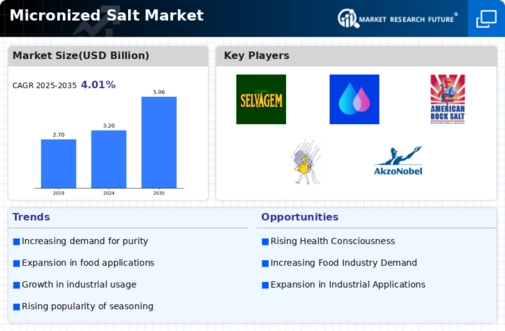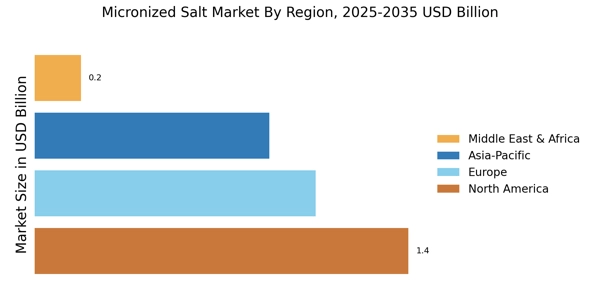Growth in Culinary Applications
The culinary sector is experiencing a notable shift towards the use of micronized salt, which is emerging as a key driver in the Micronized Salt Market. Chefs and home cooks alike are recognizing the advantages of using finer salt for seasoning, as it enhances flavor without overpowering dishes. The growing trend of gourmet cooking and the rise of culinary influencers are contributing to the increased popularity of micronized salt in kitchens worldwide. Market data indicates a surge in sales of specialty salts, including micronized varieties, as consumers seek to elevate their cooking experiences. This trend suggests a promising future for the micronized salt market, as culinary applications continue to expand.
Rising Demand in Food Processing
The food processing industry is a major consumer of micronized salt, driving demand within the Micronized Salt Market. As food manufacturers seek to improve product quality and shelf life, the use of micronized salt has become increasingly prevalent. Its ability to dissolve quickly and evenly makes it an ideal ingredient in processed foods, snacks, and seasonings. Recent market data indicates that the food processing sector accounts for a substantial share of the overall salt market, with micronized salt gaining traction due to its functional benefits. This trend is expected to continue, as food processors increasingly recognize the advantages of incorporating micronized salt into their formulations.
Health Benefits of Micronized Salt
The increasing awareness of health benefits associated with micronized salt is a notable driver in the Micronized Salt Market. Consumers are becoming more health-conscious, seeking alternatives to traditional salt that offer enhanced flavor without the negative health implications. Micronized salt, with its finer texture, allows for better absorption and utilization in the body, potentially leading to lower sodium intake while maintaining taste. This trend is reflected in market data, indicating a rise in sales of micronized salt products, particularly in health-focused food segments. As consumers prioritize health and wellness, the demand for micronized salt is likely to continue its upward trajectory, influencing manufacturers to innovate and expand their product lines to cater to this growing market segment.
Technological Innovations in Production
Technological advancements in the production of micronized salt are significantly impacting the Micronized Salt Market. Innovations in grinding and milling technologies have enabled manufacturers to produce finer salt particles with improved consistency and quality. This not only enhances the product's solubility and flavor release but also allows for better integration into various food products. Market data suggests that companies investing in state-of-the-art production facilities are experiencing increased efficiency and reduced costs, thereby enhancing their competitive edge. As these technologies evolve, they are likely to drive further growth in the micronized salt sector, attracting new players and expanding the overall market.
Sustainability and Clean Label Preferences
Sustainability concerns and clean label preferences are increasingly influencing consumer choices in the Micronized Salt Market. As consumers become more environmentally conscious, they are seeking products that align with their values, including those that are sustainably sourced and minimally processed. Micronized salt, often derived from natural sources, can meet these demands, appealing to a growing segment of eco-conscious consumers. Market data reflects a shift towards clean label products, with many manufacturers reformulating their offerings to include micronized salt as a clean ingredient. This trend is likely to drive further growth in the market, as brands that prioritize sustainability and transparency resonate with today's consumers.


















Leave a Comment